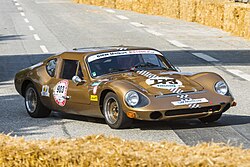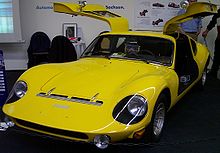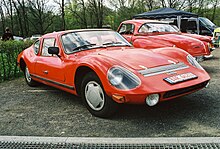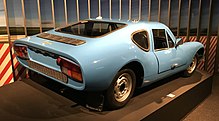Melkus RS 1000
| Melkus | |
|---|---|
|
Melkus RS 1000
|
|
| RS 1000 | |
| Sales designation: | Melkus RS 1000 |
| Production period: | 1969-1973 |
| Class : | Sports car |
| Body versions : | Coupe |
| Engines: |
Gasoline engine : 1.0–1.1 liters (51–66 kW) |
| Length: | 4000 mm |
| Width: | 1700 mm |
| Height: | 1070 mm |
| Wheelbase : | 2450 mm |
| Empty weight : | 850 kg |
| Previous model | none |
The Melkus RS 1000 is a sports car based on the Wartburg 353 , which was developed as a two-seater sports coupé under the direction of the Dresden racing driver Heinz Melkus . 101 copies were built from 1969 to 1979. The "RS" in the name stands for "racing car".
history
The idea of the Melkus RS 1000 goes back to the Lotus Elan , which Heinz Melkus observed at a racing event in 1963 in the 22nd district of Vienna. He made the decision to build a similar sports car in the GDR. In order to obtain permission from the political leadership to build a sports car, the Motor Racing Commission of the ADMV Motorsport Association submitted an application to the Central Sports Commission in November 1968 to build a sports car completely built in the GDR “in honor of the 20th anniversary of the founding of the GDR ". For this purpose, a working group consisting of representatives of the ADMV, engineers from the Technical University of Dresden , the Dresden Transport School, as well as technicians from the Eisenach automobile plant and designers from the Berlin-Weißensee School of Art was founded. Three prototypes were to be built by April 1969, followed by four more vehicles by October 1969. The first prototype was actually made in 1969. A total of 25 series vehicles were to be created. A first plaster model on a scale of 1: 5 was made in 1968. Melkus later stated that he wanted to produce a sports car similar to the Ford GT 40 , with the possibilities that existed in the GDR.
At the beginning of production there were fixed contingents for components from the Eisenach automobile plant, later the individual parts had to be bought together by automobile workshops, and assembly was improvised so that the vehicles sometimes differ from one another in detail. In some examples, even bathtub plug chains are said to have been installed as hood holders. In order to be able to acquire an RS 1000 in the GDR, a “proof of a racing activity” was required; However, the ADMV only issued such proof in exceptional cases. Relationships were also used to purchase the car, so that some vehicles were used by the upper class of the GDR population. In addition to the road version, there was also a performance-enhanced racing version of the vehicle. The new price of the RS 1000 was 30,000 marks .
Some vehicles were not equipped with the Wartburg AWE 353 engine at special customer request . Instead, engines of the WAS-2103 , Moskvich-412 and, in one case, the 2-liter BMW M10 were installed in some cars . The RS 1000 has been a collector's item since the late 1980s, but the RS 1000 was unknown outside of the GDR. Presumably only one vehicle was exported to West Germany. Although the car is a road vehicle, it can be converted into a Group 4 racing car in accordance with FIA regulations . On September 29, 2006 the Märkische Oderzeitung wrote that Melkus would reconstruct 15 RS 1000. The successor to the RS 1000, the RS 2000 , was developed from 2006 and in series production from 2009.
technical description
The RS 1000 is a mid-engine sports car built on a modified tubular frame of the Wartburg 353 with a plastic body and gullwing doors. The chassis , engine, windshield and wheels from the series production of the Wartburg 353 were also taken over for the construction; the door hinges come from the Škoda 1000 MB . The front wheels are suspended from double wishbones, a semi-trailing arm axle is installed at the rear . There are coil springs and telescopic shock absorbers on both axles, and a stabilizer is also installed on the rear axle. Tires measuring 6.5-13 in are mounted on the wheels . The braking system is a dual-circuit braking system with drum brakes all around; later, on request, disc brakes from the Polski Fiat 125p were installed on the front axle . The engine is a liquid-cooled two-stroke gasoline engine with three cylinders in series, and 992 cm 3 capacity, the performance using a modified intake and exhaust system as well as modified carburetor setting of 37 kW (50 HP) at 51 kW (70 hp) at 4750 min -1 was increased . The mixture is made up of three motorcycle slides carburetors . From 1972 the cylinder bore was enlarged by 4.5 mm, whereby the displacement increased to 1119 cm 3 ; the power remained unchanged, but the maximum torque increased from 118 to 128 Nm. For racing use, the engine was equipped with a different exhaust system and different carburetors, which increased the output to approx. 66 to 74 kW (90 to 100 hp). The torque is transmitted from the engine to the rear axle via a synchronized five-speed gearbox; the gearbox was assembled from two Wartburg gearboxes.
The aerodynamic body was supplied by Robur from Zittau. During development, the body was tested in the wind tunnel of the TU Dresden . The rear of the body behind the passenger compartment can be folded up so that the engine is accessible. Two fuel tanks with a total volume of around 60 liters are built into the door sills . The front and rear of the body are made of fiberglass-reinforced polyester , the doors and roof are made of light metal ; The vehicle weighs 850 kg in the street version, 200 kg can be loaded. The Melkus RS 1000 has a relatively small trunk (volume 48 dm 3 ). The engine is very loud and the noise insulation is insufficient. The spare wheel is stowed over the engine.
A honeycomb flat cooler, heater and blower, vehicle battery and electrical system and a small storage space are housed under the front flap in the front of the vehicle. The interior is limited to bucket seats, a wooden steering wheel , round instruments and a short gear stick.
Technical specifications
| RS 1000 street version | RS 1000 racing version | |
|---|---|---|
| engine | Three cylinder two-stroke gasoline engine, type AR 353, longitudinally in front of the rear axle fitted | |
| Mixture formation | 3 × slide carburettors with central float BVF 28 N1 / 3 | Racing carburetor BVF M6 / 36 or Jikow 36 |
| Bore × stroke | up to 1971: 73.5 mm × 78 mm from 1972: 78 mm × 78 mm |
78 mm × 78 mm |
| Displacement | up to 1971: 992 cm 3 from 1972: 1119 cm 3 |
1119 cm 3 |
| Compression ratio | 8.3: 1 | 9.5: 1 |
| rated capacity | to 1971: 70 hp (51.5 kW) at 4750 min -1 from 1972: 70 hp (51.5 kW) at 4500 min -1 |
90 HP (66 kW) at 6000 min -1 |
| maximum torque | to 1971: 12 kgf · m (117.7 N · m) at 3500 min -1 from 1972: 13 kgf · m (127.5 N · m) at 3500 min -1 |
13 kp m (127.5 N m) at 3500 min −1 |
| fuel | Regular petrol mixture in a ratio of 1: 33 | ? |
| cooling | Liquid cooling | |
| transmission | Five-speed transmission | |
| Empty mass | 850 kg (Tuček) or 690 kg (Kittler) | 680-780 kg |
| Max. Permissible total mass | 1050 kg | ? |
| Axle load distribution front / rear | 45:55 | |
| Dimensions L × W × H | 4000 mm × 1700 mm × 1070 mm | |
| wheelbase | 2450 mm | |
| Front / rear track | 1340 mm / 1380 mm | |
| Top speed | 160 km / h (Tuček), 158 km / h (Kittler) | around 200 km / h (Behling), at least 170 km / h (Kittler) |
| Acceleration 0-100 km / h | 13.4 s | ? |
| Fuel consumption | 10-12 l / 100 km | ? |
| Drag coefficient | 0.29 | |
| Brakes | Drum brakes all around, disc brakes at the front on request | |
Web links
- Melkus RS 1000 . In: melkus-sportwagen.de
- Heiko Haupt: Melkus RS 1000 - socialist hip flask . In: Spiegel Online , December 3, 2003
- Eckart Lohse: The rebirth of the zone Ferrari . In: FAZ.net , January 19, 2009
Individual evidence
- ↑ a b c d e f g h i j k l m n o p q r s t u v Eberhard Kittler: Sächsische Flounder - racing cars from Dresden: Melkus RS 1000 , Oldtimer Markt, Mainz, 11/1989
- ↑ a b Martina Wichor: Sports history: quotes - photos - anecdotes , epubli GmbH, Berlin, 2015. ISBN 978-3-7375-2990-7 . P. 197
- ↑ a b c d e f g h i j k Klaus Behling : Secrets of a Sunken Land: Entertaining anecdotes from the GDR card box , Bild und Heimat, 2015, ISBN 978-3-86789-594-1 . What was an »RS 1000«?
- ↑ a b c d e f g h i j k l Werner Oswald: Motor vehicles of the GDR, 2nd edition Motorbuchverlag, Stuttgart, 2000, ISBN 3-613-01913-2 . Pp. 103-105
- ↑ Wolfgang Melenk, Mike Jordan: Racing legend Heinz Melkus. Life's work and sports career of the Dresden automobile designer and racing driver. Delius Klasing, Bielefeld 2008, ISBN 978-3-7688-5792-5 , p. 67.
- ↑ Video and online article on Melkus ( Memento from August 8, 2007 in the Internet Archive ), Märkische Oderzeitung , March 23, 2007.
- ↑ a b c d e f g Eberhard Kittler: Typenkompass DDR - Personenwagen 1945–1990 , Motorbuch-Verlag, Stuttgart, 2000. ISBN 978-3-613-02049-8 , p. 227
- ↑ The technical data (signals 45-66). In: rheinlaenderwartburgfreunde.de. Retrieved January 17, 2018 .
- ^ Jan Tuček: Auta východního bloku . Grada Publishing as, 2009. ISBN 978-80-247-2585-7 . P. 274
- ^ Jan Tuček: Auta východního bloku . Grada Publishing as, 2009. ISBN 978-80-247-2585-7 . P. 120
Remarks
- ↑ Kittler gives the price at 28,600 marks.
- ↑ Werner Oswald, revised by Kittler, also specifies a displacement of 1250 cm 3 for racing versions of the engine, but this does not result from the specified bore of 78 mm and 78 mm stroke.
- ↑ With Werner Oswald, revised by Kittler, the output is given as 90-100 hp (66 kW) at 5250 rpm
- ↑ Klaus Behling states that the information on the mass of the racing version of the vehicle varies between 680 and 780 kg, depending on the source.
- ↑ Eberhard Kittler gives a drag coefficient of 0.30 in Oldtimer Markt 11/1989, but 0.29 in the GDR type compass - passenger cars 1945–1990; in "Motor Vehicles of the GDR" writes Kittler "Thanks to various wind tunnel investigations of the 1: 5 models, the RS achieved a c w value of 0.29"






